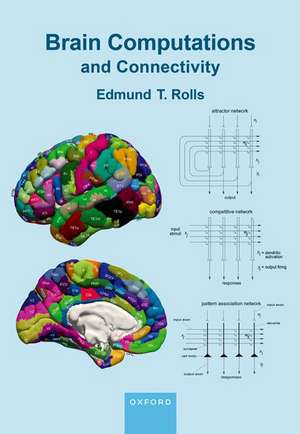Brain Computations and Connectivity
Autor Edmund T. Rollsen Limba Engleză Hardback – 11 iul 2023
Preț: 729.56 lei
Preț vechi: 1176.27 lei
-38% Nou
Puncte Express: 1094
Preț estimativ în valută:
139.62€ • 151.60$ • 117.28£
139.62€ • 151.60$ • 117.28£
Carte disponibilă
Livrare economică 21-27 martie
Preluare comenzi: 021 569.72.76
Specificații
ISBN-13: 9780198887911
ISBN-10: 0198887914
Pagini: 1184
Dimensiuni: 175 x 252 x 46 mm
Greutate: 1.8 kg
Ediția:2
Editura: OUP OXFORD
Colecția OUP Oxford
Locul publicării:Oxford, United Kingdom
ISBN-10: 0198887914
Pagini: 1184
Dimensiuni: 175 x 252 x 46 mm
Greutate: 1.8 kg
Ediția:2
Editura: OUP OXFORD
Colecția OUP Oxford
Locul publicării:Oxford, United Kingdom
Recenzii
This neuronal network approach stands in contrast to connectionist approaches and also focuses exclusively on higher primate and human modeling. Helpful chapter highlights and several practical appendixes are provided, and the bibliography is excellent.
This "bottom-up" approach to data-driven neuroscientific discovery serves as the perfect primer for those who study brain sciences, cognitive sciences, artificial intelligence, neuro-engineering, neuropsychology, and empirically oriented philosophy.
Brain Computations is the first complete attempt to summarize our current knowledge about computation in the brain, at a level a graduate can understand. ... This is a biologically grounded, full systems neuroscience textbook-which makes it one of a kind. ... Hippocampal memories, action selection in the striatum, orbitofrontal reward representations, emotion in the limbic system, cerebellar motor control, parietal spatial coordinate transforms, place fields, and posterior visual object recognition-all these can emerge from relatively simple rules. This is Rolls' unspoken but substantial grand unifying theory. (full review https://doi.org/10.1093/brain/awab477)
He concludes with 13 principles about how information in encoded in neural networks. This is almost the Holy Grail of neuroscience, the language of neurons, what makes us what we are. Yet, these ideas are presented in a simple unassuming scientific language ...
This "bottom-up" approach to data-driven neuroscientific discovery serves as the perfect primer for those who study brain sciences, cognitive sciences, artificial intelligence, neuro-engineering, neuropsychology, and empirically oriented philosophy.
Brain Computations is the first complete attempt to summarize our current knowledge about computation in the brain, at a level a graduate can understand. ... This is a biologically grounded, full systems neuroscience textbook-which makes it one of a kind. ... Hippocampal memories, action selection in the striatum, orbitofrontal reward representations, emotion in the limbic system, cerebellar motor control, parietal spatial coordinate transforms, place fields, and posterior visual object recognition-all these can emerge from relatively simple rules. This is Rolls' unspoken but substantial grand unifying theory. (full review https://doi.org/10.1093/brain/awab477)
He concludes with 13 principles about how information in encoded in neural networks. This is almost the Holy Grail of neuroscience, the language of neurons, what makes us what we are. Yet, these ideas are presented in a simple unassuming scientific language ...
Notă biografică
Professor Edmund T. Rolls performs full-time research at the Oxford Centre for Computational Neuroscience, and at the University of Warwick, and has performed research and teaching for many years as Professor of Experimental Psychology at the University of Oxford, and as Fellow and Tutor of Corpus Christi College, Oxford. His research links computational neuroscience to neurophysiological, human functional neuroimaging and neuropsychological studies in order to provide a fundamental basis for understanding how the brain operates in health and in disease.
